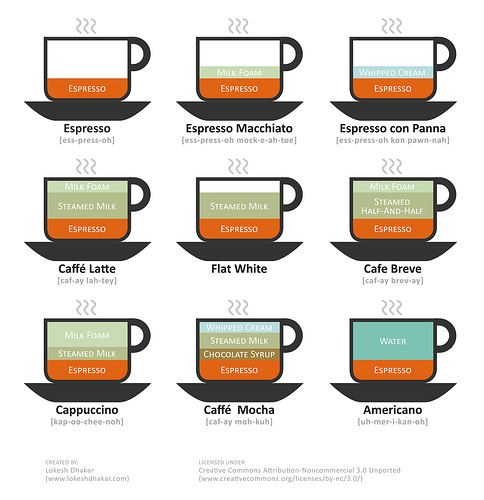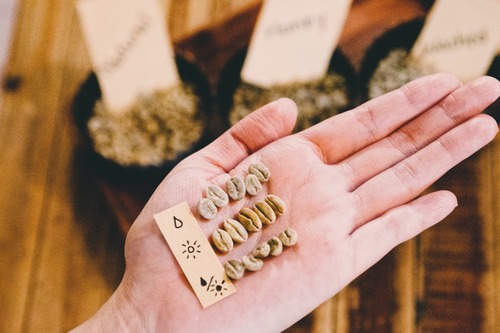[coffee special] want to mix out the taste that the guest wants? First learn how to read music and mix drinks!
Professional coffee knowledge exchange more coffee bean information please follow the coffee workshop (Wechat official account cafe_style)
Today, we are going to teach you how to read music and mix drinks.
Musicians read music, dancers read dance recipes (in ancient times), practitioners read boxing recipes, cooks read recipes, bartenders read wine recipes, and baristas read coffee recipes (to put it bluntly, recipes). When a layman looks at a connoisseur, he doesn't understand what they are looking at, but when an expert looks at it, he naturally knows what's going on.
When a musician looks at the music, there will be a melody in his head. Similarly, when the barista looks at the music, the taste of that cup should be exactly the same. But to have this ability, we must first build a good structure before you can understand what the language is. Let's take a look at this picture first.

Then, there are a few things we must know:
Espresso (espresso)
Coffee é Macciato (coffee macchiato)
Caf é Con Panna (Campbell Blue espresso)
Coffee é Corretto (Colette Coffee)
Everything is not the kind of coffee we often drink, is it? (coffee macchiato is completely different from caramel macchiato) the most common espresso we drink now, maybe 70 to 80% of people are American cabbage lattes, right? Drink "Flat White" with a little bit of tide, and Starbucks fans drink Frappuccino.
Espresso doesn't look like this in the first place. Cappuccinos and coffee lattes are available in Italy, but Italians drink breakfast, and diehard stores don't sell them in the afternoon. He will roll his eyes if you order a latte with him in the afternoon.
Why?
Well, because Italians drink those four. The most is Espresso (in fact, they are called Caf é, for them, if it is not Espresso, it should not be called "coffee" … ), drink Espresso all day long, drink three, four, five or six cups of ──, so Cabo and lattes may be more like to them: "I want to drink milk in the morning, but I want coffee anyway!" "that's it. Therefore, they will find it strange to drink that outside of breakfast.
The espresso we are drinking now is a bit like a variation after globalization. In this case, we need to start with Starbucks introducing espresso to the United States. But it's a long story. We'll talk about it next time. We can now know why espresso looks like this. ──, how can Americans drink Espresso? Think of a whole pot of coffee as light as water in an American restaurant.
But they are good at mixing drinks. And Espresso just happens to be very suitable for mixing drinks! Because it is strong enough, it can almost be used as the base liquor in mixed liquor (spirits above 40 degrees), and has the same sense of existence.
Then why did I mention the above four kinds of coffee? Because, all the classic espresso can be said to be developed from this origin.
Espresso espresso → American coffee (with water)
Coffee é Macciato Coffee macchiato (the smallest unit of coffee with milk, one cup of 60ml) → cappuccino → coffee latte → Flat White (change the amount of milk and the texture of the foam)
Coffee é Con Panna Campbell blue espresso (espresso with whipped cream) → Vienna coffee (coffee body diluted with water) → Vienna cappuccino (coffee body diluted with milk)
Coffee é Corretto Colette (espresso with spirits, one 60ml) → Irish coffee (spirits with Irish Whiskey, diluted with water and whipped cream)
If we sort it out in this way, we will have a logical thread: all espresso, with Espresso as the core, can be diluted and adjusted with some kind of side material (water, milk, wine, or if you want something different, you can try juice or tea) and can be seasoned.
Is it a lot like mixing drinks? The rest is permutation and combination.
Knowing the origin of espresso, with the whole concept, you will have a better grasp of the situation. For example, let me give you a score:
──
Espresso 1 oz
Hazelnut jam 10g
Caramel whipped cream 5g
1 ounce of foamed milk
The right amount of crushed nuts
Practice: extract Espresso, add hazelnut jam and caramel whipped cream to make foamed milk, pour into a cup and sprinkle with crushed nuts.
With the concepts mentioned above, you won't be fooled by seasoning. You will find the basic material: the ratio of Espresso to milk, and then find that this cup is most like a coffee macchiato. Then you can learn the most important thing directly: the concentration of coffee.
The same formula, the proportion has changed, the feeling will be completely different. The above recipe is to show the strength of the coffee, the whole cup will feel like a cup of dessert coffee, while if adjusted to the proportion of coffee latte, it will be more like a softer and lighter drink.
Read the spectrum, first grasp the concentration, to understand which kind of classic coffee-based drink, so that it is easier to see the concept of the designer, and the feeling he wants to present. We study in such a place when we read music.
Classic wine recipes, classic coffee recipes are classic, on the one hand, they are very close to the basics, on the other hand, they may be quite popular, or convey a certain concept or message, so that they will remain forever. Familiar with the formula, we can have a more solid foundation in the preparation of drinks, but also let us understand the context of the whole history of blending drinks, so that we can give full play to our own creativity in this context.
It is important to note that although creation can be free, sometimes it will become a kind of throbbing pain when it is out of context. For example, if you fill a hot American cup with Espresso and mix it with other flavors, it will be a kind of throbbing pain (what does it mean to be small and light? A starter?), If it is a set of drinks like a set meal, maybe it can be like this, the situation of a single cup of victory or defeat will make people feel inexplicable.
Creation is not a freewheeling idea. With the footsteps and thinking framework of our predecessors, it is more helpful for us to develop various ideas and creations. I hope this time I can give you some direction to think and learn.
Source: Muller Coffee
END
Important Notice :
前街咖啡 FrontStreet Coffee has moved to new addredd:
FrontStreet Coffee Address: 315,Donghua East Road,GuangZhou
Tel:020 38364473
- Prev

Coffee treatment the difference between washing treatment and semi-washing treatment and the flavor characteristics of coffee
Professional coffee knowledge exchange more coffee bean information Please pay attention to the coffee workshop (Wechat official account cafe_style) washing is a technology invented by the Dutch in the 18th century, suitable for rainy areas, although the process is relatively tedious, but it is currently a common method of raw bean processing, accounting for about 70% of the total coffee. Remove most of the pulp from the coffee beans by peeling the harvested fruit
- Next

Choose the most suitable treatment according to the taste! Effect of Post-treatment on Coffee Flavor
Professional coffee knowledge exchange more coffee bean information Please pay attention to the coffee workshop (Wechat official account cafe_style) every year July and August is the time when the most high-quality new beans are put on the shelves. Different producing areas, different treatments and different varieties all have a unique coffee taste. In the face of these various proper terms, how to choose the coffee flavor that best suits you? Let the editor tell you.
Related
- What is the meaning of lactic acid fermentation with coffee bean treatment?
- How to judge the state of foam by sound?
- How does the latte pull out the unicorn pattern? Come to get for a little trick to improve the flower pull!
- Will flower pulling affect the taste of the latte?
- Do you know the history of coffee?
- The difference between honey treatment and sun washing what is raisin honey treatment?
- What kind of milk can a novice use to make coffee foam to keep the foam longer? The correct method and skills of milking tutorial sharing
- Why do washed coffee beans taste sour? Flavor characteristics of washed Coffee
- Introduction to the skill of how to practice the size and height of water injection around the circle of hand-brewed coffee
- How do beginners practice coffee flower drawing from scratch?

